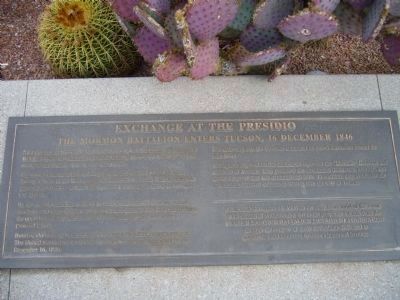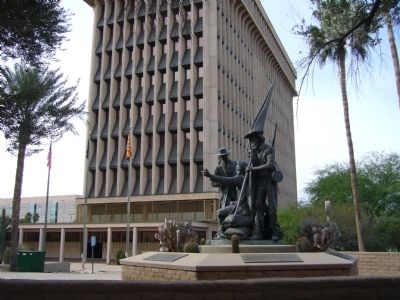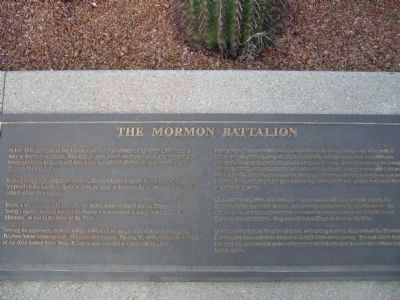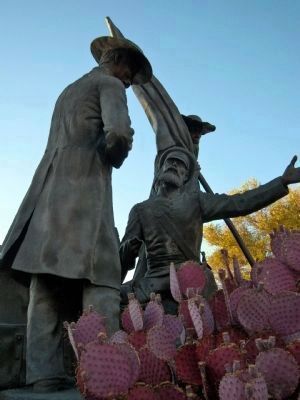Downtown in Tucson in Pima County, Arizona — The American Mountains (Southwest)
Exchange at the Presidio
The Mormon Battalion Enters Tucson, 16 December 1846
Organized in Council Bluffs, Iowa, to reinforce General Stephen Watts Kearny's Army of the West during the Mexican – American War, the battalion marched 2,000 miles to San Diego, probably the longest march in the U.S. military history.
By the time the battalion reached Tucson, it was reduced in numbers and sorely in need of provisions. Despite the fact that this was Mexican territory, the opposing military forces avoided hostilities, agreeing instead to a peaceful barter.
Buttons, clothing, and other items were traded for Mexican grain and salt. The United States Flag, the first to fly over Tucson, was posted briefly on December 16, 1846.
The following day, the battalion continued its march northward toward the Gila River.
The figures depicted on this monument represent the "Mormon" Battalion and residents of Tucson. They personify the uncommon dedication, courage, and desire for peace that was demonstrated here. In addition, they symbolize the harmonious blend of cultures in what is now the City of Tucson.
Dedicated December 14, 1996 on the sesquicentennial of the event. This memorial sculpture is a gift to the people of Tucson from Tucson Mormon Battalion Monument Foundation through the support of many individuals dedicated to preserving and honoring Arizona's historical heritage.
Erected 1996 by Tucson Mormon Battalion Monument Foundation.
Topics and series. This historical marker is listed in these topic lists: Notable Events • War, Mexican-American. In addition, it is included in the Arizona, The Presidio Trail, and the Mormon Battalion series lists. A significant historical month for this entry is December 1503.
Location. 32° 13.374′ N, 110° 58.452′ W. Marker is in Tucson, Arizona, in Pima County. It is in Downtown. Marker can be reached from West Alameda Street. Marker is in El Presisio Plaza between the Pima County Courthouse and the Tucson City Hall. Touch for map. Marker is at or near this postal address: 165 West Alameda Street, Tucson AZ 85701, United States of America. Touch for directions.
Other nearby markers. At least 8 other markers are within walking distance of this marker. Commemorating the Raising of the First American Flag within the Walled City of Tucson (a few steps from this marker); The First Presbyterian Church in Tucson (within shouting distance of this marker); Plaza de las Armas (within shouting distance of this marker); Veterans of the Battle of the Bulge (within shouting distance
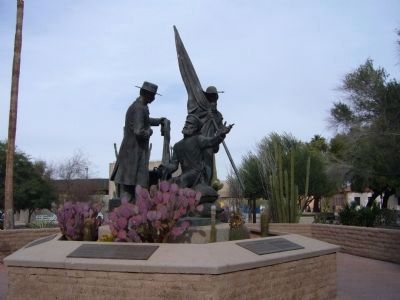
Photographed By Bill Kirchner, January 10, 2010
2. Mormon Battalion Memorial Sculpture
Click on photo to see details of sculpture.
Individuals depicted on the monument are Teodoro Ramirez, Christopher Layton and Jefferson Hunt. Plaques placed around the base of the statue give a short biography of these individuals as well as their contributions to this event.
Individuals depicted on the monument are Teodoro Ramirez, Christopher Layton and Jefferson Hunt. Plaques placed around the base of the statue give a short biography of these individuals as well as their contributions to this event.
Regarding Exchange at the Presidio. This site is #3 on the Presidio Trail Walking Tour:
"This bronze statue commemorates the day in 1846 when Mormon soldiers entered Tucson on their way to California to fight in the Mexican War. The Spanish-speaking citizenry, in spite of being nervous about these armed outsiders, threated the soldiers to a fiesta. One of the Mormon soldiers joined in the fun by playing his fiddle (note fiddle case on north side of statue)."
Also see . . . History of the Mormon Battalion. (Submitted on January 19, 2010.)
Additional commentary.
1. The Mormon Battalion
Text on Plaque seen in photo #5:
In July 1846, members of The Church of Jesus Christ of Latter Day Saints (“Mormons”)
were in desperate condition. With their prophet, Joseph Smith, martyred, they had fled their homes and farms in Illinois and were living in makeshift shelters along the banks of the Missouri River in Iowa.
Seeking escape from further prosecution, Mormon leader Brigham Young decided to resettle his people in the Far West. Early in 1846, he wrote to President James Knox Polk requesting federal aid for their exodus.
Before a response could be received, the United States declared war on Mexico. In answer to Young’s request General Stephen W. Kearny was authorized to enlist “a few hundred Mormons” as part of his Army of the West.
Sensing the opportunity to move a large number of his people west with federal support, Brigham Young encouraged the Mormons to volunteer. On July 16, 1846, the five companies of the 101st United States Army Battalion were enrolled at Council Bluffs, Iowa.
Twenty-Two officers and 474 enlisted men made up the first official roster, along with 37 woman and 53 children, many of whom were totally unfit for a march of more than two thousand miles to their destination in San Diego, California. Three times during the journey disease, hardship, and near starvation forced battalion officers to send women and children along with sick enlisted men to a small Mormon settlement at Pueblo, Colorado to wait for Brigham Young and his people who
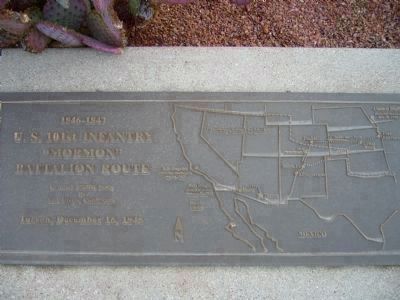
Photographed By Bill Kirchner, January 30, 2010
4. Exchange at the Presidio Plaque
[This plaque is on the southwest side of the sculpture:]
1846 - 1847
U.S. 101st Infantry
"Mormon"
Battalion Route
Council Bluffs, Iowa
to
San Diego
Tucson, December 16, 1846
[Click on photo to see detail of route highlighted on map]
U.S. 101st Infantry
"Mormon"
Battalion Route
Council Bluffs, Iowa
to
San Diego
Tucson, December 16, 1846
On December 16, 1846, with their numbers reduced to 350 men and four women, the Mormon Battalion reached Tucson. After resting and bartering for needed supplies the following day, this lean and hardened contingent continued north to the Gila River and thence to their destination. They arrived in San Diego on January 29, 1847.
Covering more than 2,000 miles of harsh, unforgiving territory, the march of the Mormon Battalion has been called the longest in United States Army history. The trail which they followed was instrumental in the settlement of what would later become southwestern United States.
— Submitted January 31, 2010.
Additional keywords. Mormon Battalion
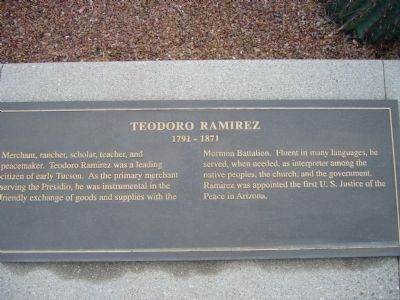
Photographed By Bill Kirchner, January 30, 2010
6. Teodoro Ramirez
[This plaque is on the northwest side of the sculpture.]:
Teodoro Ramirez
1791 - 1871
Merchant, rancher, scholar, teacher, and peacemaker. Teodoro Ramirez was a leading citizen of early Tucson. As the primary merchant serving the Presidio, he was instrumental in the friendly exchange of goods and supplies with the Mormon Battalion. Fluent in many languages, he served, when needed, as interpreter among the native peoples, the church, and the government. Ramirez was appointed the first U.S. Justice of the Peace in Arizona.
1791 - 1871
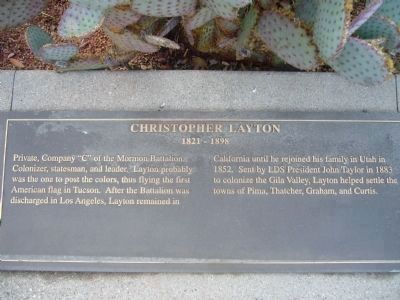
Photographed By Bill Kirchner, January 30, 2010
7. Christopher Layton
[This plaque is on the north side of the sculpture.]:
Christopher Layton
1821 - 1898
Private, Company “C” of the Mormon Battalion. Colonizer, statesman, and leader. Layton probably was the one to post the colors, thus flying the first American flag in Tucson. After the Battalion was discharged in Los Angeles, Layton remained in California until he rejoined his family in Utah in 1852. Sent by LDS President John Taylor in 1883 to colonize the Gila Valley, Layton helped settle the towns of Pima, Thatcher, Graham, and Curtis.
1821 - 1898
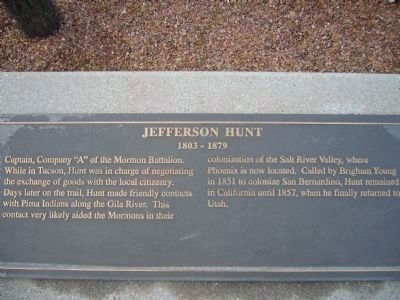
Photographed By Bill Kirchner, January 30, 2010
8. Jefferson Hunt
[This plaque is on the northeast side of the sculpture.]
Jefferson Hunt
1803 - 1879
Captain, Company “A” of the Mormon Battalion. While in Tucson, Hunt was in charge of negotiating the exchange of goods with the local citizenry. Days later on the trail, Hunt made friendly contacts with Pima Indians along the Gila River. This contact very likely aided the Mormons in their colonization of the Salt River Valley, where Phoenix is now located. Called by Brigham Young in 1851 to colonize San Bernardino, Hunt remained in California until 1857, when he finally returned to Utah.
1803 - 1879
Credits. This page was last revised on June 16, 2016. It was originally submitted on January 14, 2010, by Bill Kirchner of Tucson, Arizona. This page has been viewed 4,734 times since then and 101 times this year. Last updated on May 25, 2014, by Richard E. Miller of Oxon Hill, Maryland. Photos: 1. submitted on January 31, 2010, by Bill Kirchner of Tucson, Arizona. 2, 3. submitted on January 14, 2010, by Bill Kirchner of Tucson, Arizona. 4, 5, 6, 7, 8. submitted on January 31, 2010, by Bill Kirchner of Tucson, Arizona. 9. submitted on January 18, 2012, by Denise Boose of Tehachapi, California. • Syd Whittle was the editor who published this page.
